Where are the voters? Scott Morrison and Anthony Albanese on the campaign trail
It’s the minders leading the blind as the media caravan follows Scott Morrison and Anthony Albanese while they busily pose for campaign photos – and avoid meeting voters.

There’s nothing like the smell of cardboard in the morning. The fresh, earthy scent is almost as pleasing as the acoustic qualities that project the Prime Minister’s words as he stands before towers of the stuff to make a major announcement on jobs. Beige and stiff, cardboard might not seem the preferred backdrop for a politician chasing votes. But, somewhere in the intensely orchestrated manoeuvrings behind a national election campaign, someone has decided that the warehouse of a water heater factory in western Sydney, surrounded by towers of boxes, is the place where Scott Morrison will this morning declare to the nation his plans to create 1.3 million jobs over five years, if he’s re-elected.
Not that he makes the declaration in the presence of his intended audience; the warehouse is deep within the factory, so no regular voters can hear him. Nor does Morrison provide any specifics in his speech beyond “we can commit to a 1.3 million jobs target pledge over the next five years”. There’s no rousing cheer when his message is finally delivered – to a semi-circle of cameras. Morrison’s words will reach the nation via news outlets that day and he comfortably handles questions at the ensuing press conference. Until a rare unscripted moment that evening, his super-planned day seems to be playing out perfectly.
But not everything at this event – the first of three that the PM will front today – has been perfectly war-gamed. Within 24 hours, word will seep out that the factory will be moving some of its operations to Vietnam and shedding an unspecified number of workers. For many employees there is little work to be done this morning as they wait in the wings, forklifts silenced and the warehouse all but idle for the duration of the visit. Even being here in a factory seems symbolic, given that so much of what happens on the campaign trail is manufactured. But irony, it seems, is not a huge consideration on the hustings.
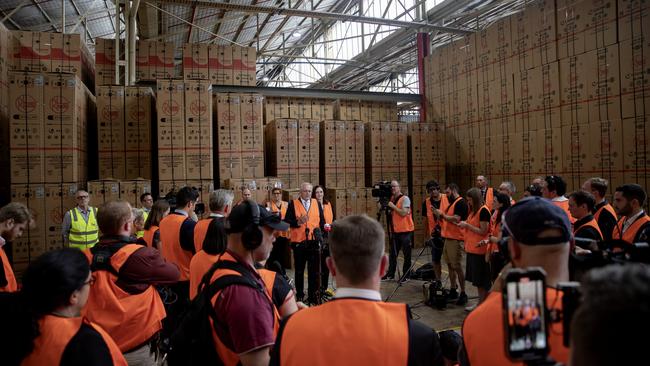
Following the leaders during a federal election is an odd experience. There’s a touch of the Beatles (Magical Mystery Tour) and children’s birthday party (Pin the Tail on the Donkey), with journalists tasked with tailing the leaders virtually blindfolded when it comes to knowing where they’re going next. But mostly it’s like being immersed in an episode of the 1960s spy comedy Get Smart. There’s a lot of control, occasionally some chaos, the day’s plans are only imparted under a cone of silence and WhatsApp messages from some minders self-destruct after seven days.
The first thing to know as a member of the media registered to travel with Prime Minister Scott Morrison or Labor leader Anthony Albanese is that you aren’t so much travelling with either of them, or even shadowing them, as being corralled to unknown locations in a separate chartered plane or bus. The second is how little you’re told in advance. For a profession reliant on information and trained to find it, it’s counterintuitive to spend weeks attending unknown events at unknown locations with mostly unknown attendees. But it’s still considered the best way to ensure comprehensive coverage of election campaigns, giving journalists some proximity to both leaders so they can probe them on announcements.
What ensues is a lot of movement with comparatively little matter. Most mornings you wake up in a strange town and wait for a group WhatsApp message from a party minder about the day’s first event. Sometimes the details are revealed minutes before arrival, when you are already in the air or on the road. Shortly after you have set up your recording gear, the leader arrives, does a tour or a press conference, and then the show moves on. You traverse great lengths of the country but those long hours on the road are in inverse proportion to the few minutes a day you are in the presence of either prime ministerial aspirant. You are reminded of voters constantly but, as a result of your highly controlled itinerary, you rarely encounter them. Big announcements are frequently made before few people, and every highly planned step has a single aim: to generate the perfect image.
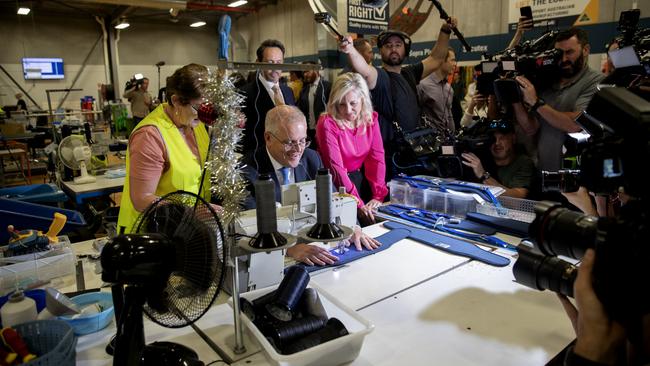
See Scott Morrison sew. See him drill. See him shake the paw of a retired assistance dog named Shannie. For the advance parties charged with organising a leader’s itinerary, visuals matter, even if the quality of discourse doesn’t always match. “I remember the first hot water heater we ever got at our place, it was a Rheem,” an energetic Morrison informs management as he alights at the water heater factory, dozens of metres from the road and the nearest constituent, and begins a tour.
It is a weekday morning early in the six-week campaign. After leaving their Sydney hotel, the media had been driven through the city for eight minutes before a minder at the front of their charter bus notified them of this destination. Like all campaign plans, that information was imparted with the proviso that no details be released until the event’s start at 9.30am, when Morrison, treasurer Josh Frydenberg, foreign minister Marise Payne, as the patron senator for Western Sydney, and Maria Kovacic, the Liberal candidate for Parramatta, began a tour of the Rydalmere factory that would “highlight cylinder manufacturing”.
Morrison arrives on time. Donning a fluoro safety vest, as he will do repeatedly over coming weeks, he moves from workbench to welders through the sparsely staffed space, his limited audience of factory workers no hindrance to campaigning. “You can’t make these things without gas,” he informs one worker as he darts through the cavernous factory, encircled by a 40-strong media pack (including his own photographer and videographer) that moves with him like a giant praying mantis. He talks to perhaps five workers for a few moments each and his tour concludes in minutes. In the end he spends almost as long addressing the media. On his day and a bit in western Sydney, Morrison visits three factories and a paddock. He meets a few workers but in this corner of Australia’s biggest city, the biggest crowd he encounters is the media.
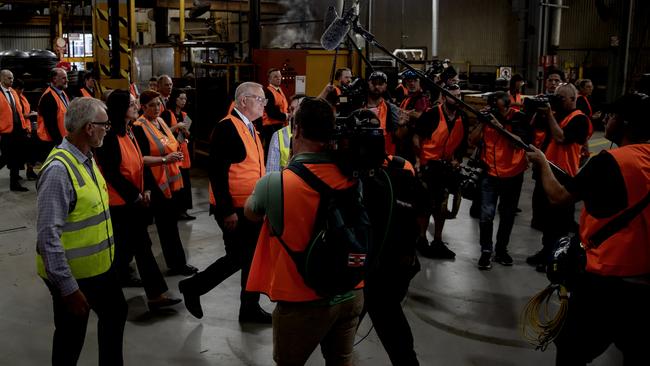
Darren Hogan is not excited. In the minutes before Morrison’s car drives into the engineering plant his family has run since 1947 in Mulgrave, in Sydney’s north-west, cameras and journalists already swarming across the front courtyard, he is smiling but anxious. A few days ago he was called by the partner of Sarah Richards, the Liberal candidate for Labor-held Macquarie, the nation’s most marginal seat: “How would you feel if a really important politician was to arrive at your place?” Hogan did not like the idea, no matter who the unnamed MP was. “I was too nervous.” But at his partner’s persuasion he relented.
Now he’s waiting in the driveway near the demountable office for a delegation including the Prime Minister, the treasurer and the foreign minister, and he’s still anxious. Morrison, though, soon puts him at ease as he accompanies him through the tool shop past piles of excavator buckets. Hearing a little about the company’s 20 employees, the PM offers a few words to workers about his government’s achievements. “One of the things we did economically [as the pandemic hit] was that we decided that unless we did something straight away that we would lose every single apprentice in Australia.” The session’s money shot takes place at an old machine where Morrison tries his hand at drilling a hole in a pin for an excavator bucket.
“All I can say is ‘wow’,” a delighted and relieved Hogan says as his guests drive away minutes later. In this brief visit the Prime Minister has not addressed the journalists scurrying around him, no announcements have been made and, apart from the resident workers, no voters have been sighted. But in this most marginal electorate, his presence has been captured for tonight’s news and left one business operator chuffed. “That was exciting,” says Hogan. “He was terrific.”

For all the control of information on the campaign, attention to detail can also be a façade. “We got a phone call last night: ‘The PM is going to be here tomorrow’,” says a still incredulous Bob Biggs as he stands in a paddock in Orchard Hills, near Penrith, and waits for Morrison to attend his third event of the day.
Twenty six years ago, Biggs founded Assistance Dogs Australia to help train canines for veterans with Post Traumatic Stress Disorder, children with autism and people with physical disabilities. The organisation can turn out 40 dogs a year but demand is so great that there is a two-year waiting list. To meet those needs, the group bought this paddock in outer-west Sydney, which also happens to be in the Liberal-held bellwether seat of Lindsay, and spent years attaining council approval to build kennels and accommodation.
Covid hit just as they began to seek funding. “We didn’t think we were going to get it,” says Biggs, who, as a director, has long assumed that the organisation would have to raise millions of dollars itself. Then came last night’s phone call. “We don’t even know how much [the funding pledge] is yet,” says a nervous and excited Biggs as he stands in a business suit in the field that will one day accommodate both dogs and humans.
An upbeat Morrison arrives mid-afternoon and strides through the overgrown grass, shakes the paw of a retired assistance dog and pats another. In a brief speech beside the PM, Liberal MP Melissa McIntosh reveals the Morrison Government, if re-elected, will give the organisation $2 million. This will mean turning out 120 dogs a year, tripling current capacity. Biggs considers the announcement as momentous an event as starting the organisation a quarter of a century ago. He is stunned. After all this time it happens, just like that.
By the time Morrison is driven away it is late afternoon. The last official event of the day is over. After eight hours on the road, none of the travelling media knows where they will be sleeping tonight.
There is no official reason for the intense secrecy surrounding the leaders’ campaigns and how far they have strayed from the traditional images of politicians kissing babies and walking through shopping malls to meet voters. Security is a concern but there’s also a desire to control the flow of information, with no chance for leaders to be upstaged by noisy activists or disgruntled voters.
“People now are likely to say or do anything,” says The Australian’s national editor Dennis Shanahan, who is covering his 13th consecutive federal campaign for the paper. “What used to happen was that the leaders would pop up at a local supermarket or restaurant or go for a walk to the beach and people would be respectful. They would then turn around to the journalists afterwards and say, ‘I’m not going to vote for him.’ But they were being polite in his presence.”
The sheer numbers of journalists now wanting to cover campaigns necessitates separate vehicles, which in turn keeps them further from leaders. (“Forty years ago,” says Shanahan, “the leaders would have a plane and there was enough room for all the journos who were travelling because there were only half a dozen.”) There are also concerns about the immediacy of social media and the rise of photo bombers. As Shanahan says, “If there’s somebody there with a phone, you can get caught.”
Which is just what Morrison and his dinner companions discover on his night in western Sydney. Party leaders have for years met informally with media covering their campaigns for a drink and sometimes a meal. On this weeknight Morrison’s team arranges for the media busload to meet him at a riverside club in Penrith (Albanese held drinks for media the previous evening). While anything said in the tiny public entrance may be reported, anything that happens inside the large glassed-in space that the PM’s team has reserved for the evening is off the record.
This all changes when a video is posted on TikTok later that night. Although Morrison’s security personnel are present, 20-year-old political activist Adisen Wright manages to enter the room, walk up to the Prime Minister and record their encounter. “Scomo, I just wanted to say hi,” he begins affably, if awkwardly, and briefly stumbles over his words. “I’m pretty astounded as a young bloke here. Good to see you. Can I get a photo?”
“Sure,” Morrison replies, as Wright turns the camera towards him. “Are you in the press pack?”
“No, I’m a local, I live up in the mountains,” he says pleasantly. “Can I ask you one question?”
Then Morrison realises the young man is recording their meeting. “Mate, I’m sorry, this is a private event.” As an aide intervenes and Morrison walks away, Wright’s voice quickly rises to a roar. “Across the river here, people lost their houses and they were burnt. You are a disgrace.” His final words are yelled in anger and shatter the convivial conversations happening around the room.
Wright quickly calms down after he is escorted outside by police (“I got a photo, I wanted to ask a question, I wasn’t being a dick and then he didn’t want to talk to me, and that’s fair. I didn’t know it was private. My mate said he was coming round, come for a beer”). But the encounter is unexpectedly menacing and leaves some of those inside shaken. There is another reason it is notable. During his day and a half in western Sydney, it is also the only time the Prime Minister has an unplanned encounter.
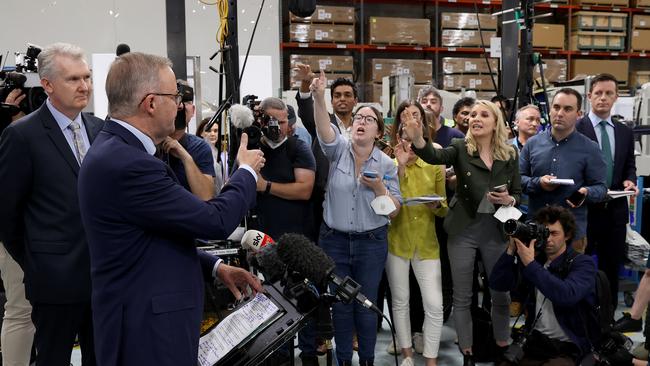
See Anthony Albanese climb a staircase. See him pat a dog. See him order a coffee. On another day on another bus chasing another leader, some themes are similar but there are a few differences. Most notable is that unlike those journalists shadowing the Prime Minister, who has recently recovered from Covid, those travelling with Anthony Albanese (who has not yet been struck by the virus) face specific requirements: a negative rapid antigen test every three days and N95 masks at all times on the bus.
Otherwise it’s campaign life as usual. “l’ll show you the address because these guys don’t know,” a Labor media minder tells a Hunter Valley bus driver of the next intended destination as journalists begin to board the vehicle. It is well before 8am and media will be on the road for almost 11 hours today, taking a 5.30am bus to Sydney airport, a flight to Newcastle, two bus trips of about 45 minutes each, a 90-minute drive back to Newcastle airport, a flight to Sydney and a bus ride back to a city hotel. All for the opportunity to spend less than an hour in Albanese’s presence and record encounters with only a handful of selected people.
Like Morrison, Albanese spends most of the day not meeting voters. In the Labor-held seat of Hunter, where long-term member Joel Fitzgibbon is retiring, his first stop is on a footpath outside Cessnock Hospital, one of 50 emergency clinics he plans to open to address hospital waiting times. The establishment of the clinics has already been widely reported, and with no further details forthcoming today’s long trek to Cessnock is mostly a chance for Albanese to be seen with the handful of nurses waiting for him and with the towering Labor candidate for Hunter, Commonwealth Games gold medal shooter Dan Repacholi.
The hospital entrance is off a small suburban street. To access it, Albanese technically takes a walk in public, but only just: from his car, he passes one home as he proceeds to a nondescript spot on the footpath opposite the hospital, where he spends several minutes hearing from uniformed members of the NSW Nurses and Midwives’ Association about the lack of staff to service the mushrooming local population. “We don’t have doctors here all the time,” one frustrated nurse reveals. The opposition leader listens intensely for several minutes and then moves a few metres along the footpath, where cameras and journalists are positioned to ask him questions.
This is his only public discourse for the day, the closest he will come to making any newsworthy pronouncements in 24 hours, and he does this on a rough patch of pavement flanked by an unruly hedge and a road pocked with potholes. Amid the barrage of sometimes hostile questioning a young reporter tosses him the easiest query: what is the hardest day of work he has ever had? “I’ve got to say there were days at Pancakes on the Rocks that were pretty tough,” he says of his overnight shifts as a young man, before going on to recount another job that involved cleaning decades of pigeon poo from a wharf roof on Sydney Harbour.
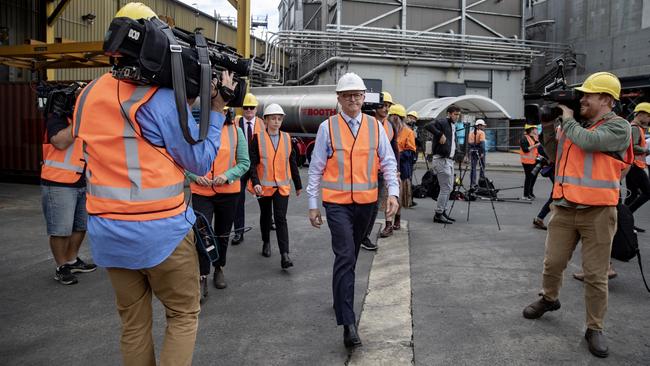
It’s not the most polished response, but the real breach in stage management happens moments later. After posing for a photograph with nurses, Albanese is suddenly approached by an older woman. “All the very best,” says a delighted Evelyn Parkinson as she shakes his hand and he returns to his car.
Parkinson is thrilled. She has rushed over from Woolies after her husband told her the Labor leader was outside the local hospital. “I’ve got prawns and salmon in the back,” she says of her mad morning dash. “I wanted to shake his hand.” She’s met Bob Hawke and Julia Gillard, but this is her first encounter with the man she hopes will become prime minister. “I’ll have to move to New Zealand if he doesn’t win,” she says before driving off, unaware her handshake is special in another sense: for the man hoping to become Australia’s next leader it is a rare random public encounter.
Albanese’s only other event today is 40 minutes away at the Mt Thorley mine workshop, 50km from Cessnock. It’s an isolated spot, comparatively sparsely staffed and full of massive vehicles. For more than 20 minutes, jacket off, he moves around the enormous workspace chatting to the handful of workers – “I’ve missed [contracting Covid] till now. My team are wondering how is it possible given how many people I’ve met.” Surrounded by oversized front-end loaders and haul trucks, he poses for photos with Repacholi. With no words to the media and no announcements, it seems a long way to travel for an image.
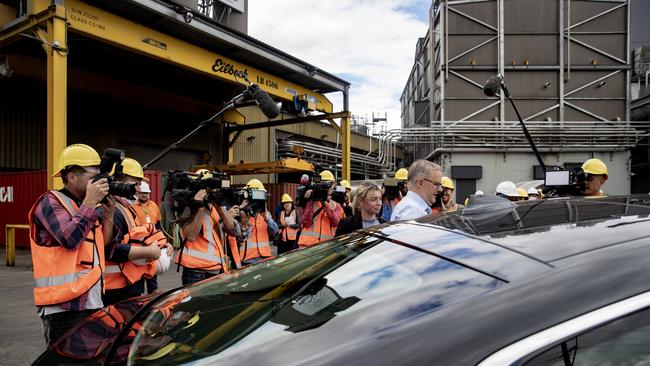
In the hours before everything changes, Albanese flies to NSW. Today is another day of solid travel: a 6.15am bus from central Brisbane to the airport, a charter flight to Nowra on the south coast, multiple bus rides and a flight to Sydney. Albanese’s advance team, who have been scouting Bomaderry, 150km south of Sydney, in recent days, have decided on a huge ethanol factory as the location of today’s press conference. The opposition leader scales an outdoor staircase so he can be photographed in a hard hat on the distillery’s balcony. Further down the busy road that fronts the factory a podium has been set up in a courtyard between a stack of palettes and the back end of a tanker. Here Albanese, flanked by shadow minister for industrial relations Tony Burke and local member for Gilmore Fiona Phillips, talks about the need to support Australian manufacturing and jobs and use clean energy. There are more electioneering soundbites than in the Hunter (“Scott Morrison always goes missing and he always blames someone else”) but no major revelations.
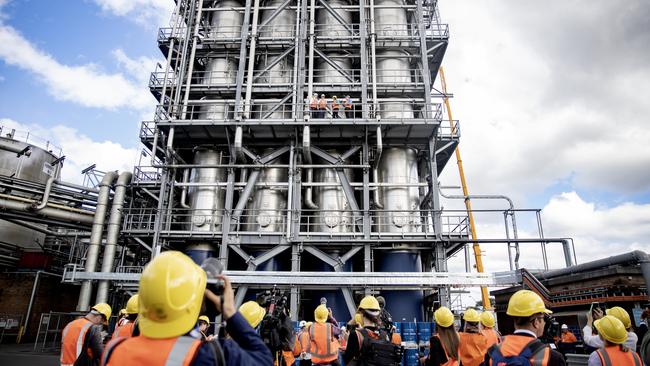
On the way out, Albanese stops for a photograph with a worker. Repeatedly on the campaign trail, onlookers are astonished by the sudden arrival of the media swarm, dozens of people scurrying around and sometimes running after the leaders, carrying microphones and cameras. “Wherever I go now I am accompanied by 100 of my closest friends,” Albanese wryly tells a group of residents at a Nowra retirement village later that morning, where, diligently masked, he moves around the modern communal lounge and asks the elderly residents about their lives. Dozens of journalists and cameras are crammed into the usually spacious room, where morning tea has been laid out on a large dining table.
After another flight and two more drives Albanese arrives at his next location, unaware that his campaign is about to be temporarily halted. At the Top Ryde City shopping centre in Sydney’s inner north-west that afternoon there is finally an election walk through a shopping mall – but it is just the media walking from their bus on the other side of the centre. Albanese’s car stops much closer to the cafe, so he has only a brief walk on busy Blaxland Road before striding with Jerome Laxale, Labor’s candidate for the Liberal- held seat of Bennelong, to an outdoor cafe table where five local voters have been recruited to sit and wait for him.
Albanese enters the cafe with their coffee orders. By the time he returns to the table a crowd, attracted by the gaggle of cameras and bodies, has formed: a mother with a pram jumps onto a bench to take a photo, schoolboys stand and snigger, and staff at the laser rejuvenation clinic stare in amazement at the sudden commotion on an otherwise quiet Thursday afternoon. Albanese’s “casual coffee” involves more than 40 people, half a dozen hot beverages and an ever-encroaching group of onlookers, boom microphones and lenses. Amid the handshakes and smiles, no one is aware that within hours he will test positive to Covid and be taken off the campaign trail for a week.
Among those witnessing the mayhem is a masked elderly woman pulling a shopping trolley through the centre. She stops briefly to take in the carefully orchestrated moment and raises her eyebrows. “All for the election,” she declares disdainfully, and scampers off.


To join the conversation, please log in. Don't have an account? Register
Join the conversation, you are commenting as Logout